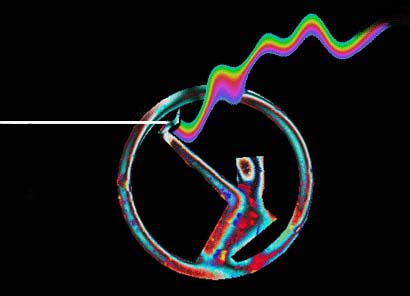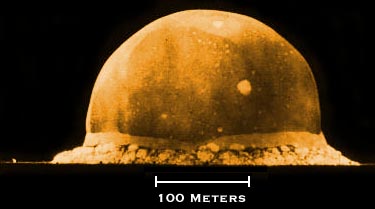 The Structure of The Universe
The Structure of The Universe The Structure of The Universe
The Structure of The UniverseOur nearest galactic neighbor, the Andromeda Galaxy, is about 2.2 million light years away.
The galaxies fall into clusters and form strings of clusters that form a web that extends in every direction, reaching out past any infinity we might be able to imagine. Between the strings, are vast tracts of 'empty' space, probably adrift with non-radiant flotsam and jetsam, and yes, organic building blocks. It is known through spectrographic analysis that comets' slush contains a high concentration of organic building blocks-cyanogen, carbon monoxide, formaldehyde and even formic acid, forming in resinous globules on the hard surfaces of cosmic dust/slush. The matrix of these accretions provides an environment in which ever more complex chemistry can occur. (see: Lyall Watson's 'Lifetide',& C. Sagan. Interstellar Organic Chemistry, Nature 238; 77-80, 1972)

Hubble Deep View Showing 100's of hitherto unknown galaxies
(The Hubble Telescope was aimed into a black spot in space where nothing had
ever been detected. The film was exposed for ten days, and this
was the resulting photograph.)
Each of the galaxies above contains 100's of millions of stars, many of them identical to our own sun. Just think of the infinite variety of civilizations that have risen and fallen throughout the endless reaches of space/time.

When some stars burn out, they collapse into themselves and become intensely compacted. Their attractive force increases and they begin to pull surrounding matter into themselves.
Weighing millions of tons per cubic centimeter, the expired star's gravitational field becomes so strong that even light cannot escape from it. At this point it becomes a 'singularity,' or a Black Hole. We think perhaps the centers of entire galaxies are black holes, pulling the mass of billions of stars and planets into the tiny vortex.
Because light disappears into the singularity, a viewer would not actually be able to see it. It is hidden behind what we call the 'event horizon'.

Here's a Deep Look at Hubble's Law
The universe expands and contracts, pulsating stroboscopically, a cosmic drumbeat.
|
In 'Drumming at the Edge of Magic', Micky Hart
quotes German jazz historian Joachim
Ernst-Berendt's book "Nada Brahma: The World is Sound":
"Since the one thing we can say about fundamental matter is that it is vibrating and since all vibrations are theoretically sound, then it is not unreasonable to suggest that the unverse is music and should be perceived as such."
"A STONE IS FROZEN MUSIC"
|
A point on the equator of Earth moves about 1,000 miles an hour around the axis. The Earth in its orbit around the sun moves 67,000 miles an hour, and the sun is moving towards the star Vega at about 1400 miles an hour. Comparable velocities affect bodies on the atomic or quantum level as well.
|
How fast the earth rotates at six locations:
At the equator: 1,000 mph At Mexico City: 900 mph At Los Angeles: 825 mph At Philadelphia: 800 mph At Stockholm, Sweden: 700 mph At Barrow, Alaska: 650 mph |
With all of this movement going on at once, its amazing that we can ever experience stillness.
At any given moment, there are approximately 2000 thunderstorms occurring on Earth. This results in the planet being struck by lightning an estimated 100 Times a Second.

We know that atoms consist basically of light, harnessed into specific shapes. Then is a rock, which is made of light, moving at the speed of light? Light's 'speed' seems to be a rather slippery concept.
"I may look like I'm sitting here doing nothing, but on the cellular level, I'm actually quite busy!"
![]() One
Billion Seconds is 32 and a half years...
One
Billion Seconds is 32 and a half years...
One Trillion seconds is Thirty-two-thousand, five hundred years...
You Are the Crown of Creation
ALL of the universe is one, flowing, fractal mind-form - we call it God, Goddess, Brahman, Allah, Buddhahood, Ahura-Mazda, El-Shaddai, Jah, Manitou, Tao, math, language, chemistry, history, religion, humor, evolution, and infinitely more. It is "center everywhere, circumference nowhere -" we are the center of the universe, because it is infinite. And we are also an insignificant speck, a bubble on the cosmic oceans.
Our measurement of time is a human invention, based on the periodicity of day and night, the seasons, and our own mortality. But in the context of infinity, time is meaningless. Evolution/Creation is never/always finished.
|
CHIEF BLACK ELK |

Attack  Big
Bang
Big
Bang ![]()
 LINKS
LINKS  Shortcuts
Shortcuts

This is the first .016 Seconds of a Nuclear (Trinity) Blast, when the event is still in the plasma form.